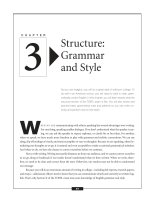SATchem01Atomic structure periodicity
Bạn đang xem bản rút gọn của tài liệu. Xem và tải ngay bản đầy đủ của tài liệu tại đây (177.88 KB, 2 trang )
SC1 – O’Malley SAT II Review (Atomic Structure & Periodic Trends)
For 1 – 5:
a. Alkali metals
b. Alkaline Earth metals
c. Metalloids
d. Halogens
e. Rare earth metals
Which has seven valence
electrons?
7.
Which has an electron
configuration 1s22s22p63s23p1?
Which has the same electron
configuration as the neon atom?
1.
Which of the following is used
primarily in semiconductors?
8.
2.
Which occur as diatomics?
9.
3.
Which make oxides with the
formula X2O?
4.
Which have large electronegativity
values?
Which have small ionization
energies?
For 6 – 9:
a. Na+
b. Al
c. F
d. Ti
e. B
12. Which consist of atoms that have
valence electrons in a d subshell?
6.
Which has valence electrons in the
d orbitals?
For 10 – 14:
a. Alkali metals
b. Alkaline Earth metals
c. Noble gases
d. Halogens
e. Transition metals
5.
10. Which are the most unreactive
family of elements?
11. Which form negative ions in an
ionic bond?
Q
18.
19.
Statement I
The metalloids have similar characteristics
Metals are good conductors of heat and electricity
Because
Because
Because
20.
21.
Elements in a group have similar properties
The first ionization energy for an atom is greater than the
second ionization energy
Sodium has a smaller atomic radius than chlorine
Because
Because
Carbon’s electric configuration is 1s22s22p2 rather than
1s22s23s2
The properties of phosphorus should be closer to those of
sulfur than to those of nitrogen
The halogens, in group VIIA, all form stable diatomic
molecules
Metals are good conductors of electricity
Two electrons in the 2s subshell must have opposite spins
Because
40
Ca is a neutral atom
The most important factor in determining the chemical
properties of an element is the number of electrons in the
outermost shell
Iron is an element
Because
Because
An element (X) with an atomic number of 16 has 14
electrons in X2Atomic radii increase down a group
Because
22.
23.
24.
25.
26.
27.
28.
29.
30.
31.
32.
Because
Because
Because
Because
Because
Because
Because
13. Which exist as diatomic molecules
at room temperature?
14. Which group possesses the lowest
first ionization energy in their
respective period?
For 15 – 17:
a. Bohr model
b. deBroglie’s wave hypothesis
c. Heisenberg’s uncertainty
principle
d. Quantum theory
e. Atomic theory
15. Which principle provides that all
matter may be considered a wave?
16. What views electrons in true orbits
around the nucleus?
17. What considers that one cannot
know position and velocity of an
electron at the same moment?
Statement II
Their valence shells have the same configuration
The positive nuclei are surrounded by a “sea” of mobile
electrons
Their valence shells have the same energy
The closer an electron is to the nucleus, the more difficult
it is to remove
A sodium atom does not have as many valence electrons
as a chlorine atom does.
3s electrons are lower in energy than 2p electrons
Phosphorus and nitrogen are in the same row of the
periodic table
They each need one electron to fill their outer shells
They are held together by ionic bonds
The Pauli exclusion principle states that no two electrons
in the same atom can have identical quantum numbers
It has the same number of protons and neutrons
The number of electrons in the outermost shell determines
the bonding characteristics of the element
It cannot be broken into smaller units and retains its
physical and chemical properties
It has gained two electrons
The higher the atomic number within a group, the smaller
the atom
33. The element with atomic number
32 describes
a. A metal
b. A non-metal
c. A metalloid
d. A halogen
e. A noble gas
35. The transition metals are
characterized by
a. completely filled d subshells
b. completely filled f subshells
c. partially filled d subshells
d. partially filled f subshells
e. both (a) and (c) are correct
34. How many neutrons are probably
in the nucleus of an element of
atomic weight 197?
a. 43
b. 79
c. 83
d. 100
e. 118
36. Neutral atoms of F (fluorine) have
the same number of electrons as
a. B3b. N+
c. Ned. Nae. Mg3+
37. Which of the elements in Group 1A of
the periodic table has the greatest
metallic character?
a. H
b. Li
c. Na
d. K
e. Rb
38. The ionization energy of an
element is
a. a measure of its mass
b. the energy required to remove
an electron from the element
in its gaseous state
c. the energy released by the
element in forming an ionic
bond
d. the energy released by the
element upon receiving an
additional electron
e. none of the above
39. Elements in a row have the same
a. Atomic weight
b. Maximum azimuthal quantum
number (l)
c. Maximum principal quantum
number (n)
d. Valence electron structure
e. Atomic number
46. Which of the following has the
lowest electronegativity?
a. Ca
b. Cl
c. Cs
d. P
e. Zn
47. Which element has the greatest
electronegativity?
a. Chlorine
b. Oxygen
c. Sulfur
d. Phosphorus
e. Fluorine
40. Which of the following has the
largest radius?
a. Sr
b. P
c. Mg
d. Al3+
e. Mg2+
48. Transition metal compounds
generally exhibit bright colors
because
a. The electrons in the partially
filled d orbitals are easily
promoted to excited states
b. The metals become
complexed with water
c. The metals conduct electricity,
producing colored light
d. The electrons in the d orbitals
emit energy as they relax
e. Their valence electrons cause
them to bind to other metals
41. Which of the following elements
has the lowest electronegativity?
a. Cesium
b. Strontium
c. Calcium
d. Barium
e. Potassium
49. Which of the following is a nonmetal?
a. Fr
b. Pd
c. I
d. Sc
e. Sr
42. Which of the following is biggest in
size?
a. Ca
b. Ca+
c. Ca2+
d. Cae. Ca2-
50. Which of the following has the
greatest affinity for electrons?
a. F
b. Cl
c. Br
d. K
e. C
43. The order of the elements in the
periodic table is based on
a. the number of neutrons
b. the radius of the atom
c. the atomic number
d. the atomic weight
e. the number of oxidation states
51. Which of the following is the most
electronegative element?
a. He
b. I
c. N
d. O
e. C
44. The elements within each column
of the Periodic Table
a. have similar valence electron
configurations
b. have similar atomic radii
c. have the same principal
quantum number
d. will react to form stable
elements
e. have no similar chemical
properties
52. Which of the following is not a
property of Group IA elements?
a. Low ionization energies
b. Low electronegativities
c. High melting points
d. Metallic bonding
e. Electrical conductivity
45. Which of the following has the
highest 1st ionization energy?
a. Ga
b. Ba
c. Ru
d. F
e. N
53. Arrange the following elements in
order of decreasing nonmetallic
character: Ge, Sn, Pb, Si
a. Pb, Sn, Ge, Si
b. Ge, Sn, Pb, Si
c. Si, Ge, Sn, Pb
d. They all have equal
nonmetallic character since
they are all in the same
column of the Periodic Table
e. None of the above
54. Electron affinity is defined as
a. the change in energy when a
gaseous atom in its ground state
gains an electron
b. the pull an atom has on the
electrons in a chemical bond
c. the energy required to remove a
valence electron from a neutral
gaseous atom in its ground state
d. the energy difference between an
electron in its ground state and its
excited state
e. none of the above
55. Which of the following is an incorrect
association?
a. Mendeleev-periodic table
b. Faraday-electrolytic cells
c. Millikan-charge of electrons
d. Rutherford-photoelectric effect
e. They are all correct
56. Members of group 1 have similar
reactivity because they have
a. the same number of protons
b. the same number of electrons
c. similar outer shell configurations
d. valence electrons with
1.
the same quantum
2.
numbers
3.
e. the same number of
4.
5.
neutrons
57. Boron found in nature has an
atomic weight of 10.811 and
is made up of the isotopes
10
B (mass 10.013 amu) and
11
B (mass 11.0093 amu).
What percentage of naturally
occurring boron is made up
of 10B and 11B respectively?
a. 30:70
b. 25:75
c. 20:80
d. 15:85
58. The modern periodic table is
ordered on the basis of
a. atomic mass
b. atomic radius
c. atomic charge
d. atomic number
e. number of neutron
59. The electron configuration
1s22s22p63s23p64s23d7
represents an atom of the
element
a. Br
b. Co
c. Cd
d. Ga
e. Mg
60. A neutral atom whose
electron configuration is
1s22s22p63s23p64s23d104p65s
2
4d105p6 is
a. Highly reactive
b. A noble gas
c. A positively charged ion
d. A transition metal
e. A lanthanide element
6.
7.
8.
9.
10.
11.
12.
13.
14.
15.
16.
17.
18.
19.
20.
21.
22.
23.
24.
25.
26.
27.
28.
29.
30.
31.
32.
33.
34.
35.
36.
37.
38.
39.
40.
41.
42.
43.
44.
45.
46.
47.
48.
49.
50.
51.
52.
53.
54.
55.
56.
57.
58.
59.
60.
C
D
A
D
A
C
B
A
D
C
D
E
D
A
B
A
C
TF
T T CE
TF
FT
FT
TF
FF
T T CE
TF
T T CE
TT
T T CE
T T CE
FF
TF
C
B
C
E
E
B
C
A
A
E
C
A
D
C
E
A
C
B
D
C
A
A
D
C
C
D
B
B









